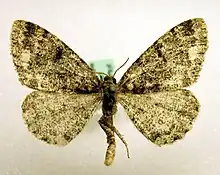| Parectropis similaria | |
|---|---|
 | |
| Scientific classification | |
| Kingdom: | |
| Phylum: | |
| Class: | |
| Order: | |
| Family: | |
| Genus: | |
| Species: | P. similaria |
| Binomial name | |
| Parectropis similaria | |
| Synonyms | |
| |
Parectropis similaria, the brindled white-spot, is a moth of the family Geometridae. The species was first described by Johann Siegfried Hufnagel in 1767. It is found in most of Europe.[2]

4,4a,4b,4c Larvae in various stages
The wingspan is 33–39 mm. The moth can be distinguished from its congeners by the white spot next to the wavy line on the outer edge of the front wing. Adults are on wing in May and June.[3]
The larvae feed on the foliage of Quercus and Betula species. The larvae can be found in autumn.
References
- ↑ Savela, Markku. "Parectropis similaria (Hufnagel, 1767)". Lepidoptera and Some Other Life Forms. Retrieved February 7, 2019.
- ↑ Fauna Europaea
- ↑ UKMoths
External links
Wikimedia Commons has media related to Parectropis similaria.
This article is issued from Wikipedia. The text is licensed under Creative Commons - Attribution - Sharealike. Additional terms may apply for the media files.